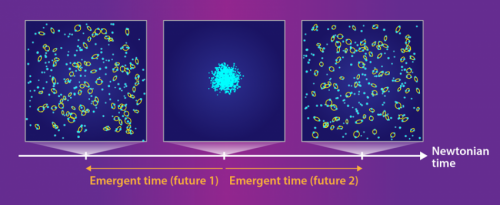November 3, 2014 report
Physicists propose identification of a gravitational arrow of time

(Phys.org) —A trio of physicists is proposing a new direction for understanding the concept of time. In their paper published in the journal Physical Review Letters, Julian Barbour, of College Farm in the U.K., Tim Koslowski of the University of New Brunswick in Canada and Flavio Mercati of the Perimeter Institute for Theoretical Physics also in Canada, describe their new ideas beginning with the suggestion that initial conditions don't necessarily need to be imposed on time-symmetric law when attempting to describe solutions to behaviors that define an "arrow of time."
For all the advances made in understanding the world around us, there are still two very basic fundamental concepts that have defied explanation: time and gravity. Though we have progressed greatly in measuring both and using both to understand other concepts, we still today are no closer to understanding either than we were when we first conceptualized them. Such an acknowledgment suggests that we likely have a major flaw in our understanding of the universe. In considering such a possibility, the three physicists with this new effort suggest we might look at time in a completely new way—by dividing a dynamically closed universe (ala the Newtonian N-body problem) into two halves with shape complexity growing from a single point—each solution to the problem can then be considered as having one past but two distinctly futures. In such a scenario, an observer would of necessity have to exist on one side or the other, and thus would only ever have that perspective. Critical to this idea is that the all of the energy and angular momentum in such a system would have to be zero.
In essence, the team has removed time from mathematical functions that describe the energy of the universe—that's what allows for splitting the equations that have been created to describe the evolution of the universe into two parts, with both having initial low complexity moving to higher complexity (similar in some respects to theories of time based on entropy).
The proposal by the trio though phrased in a way as to suggest it's a solution to the arrow of time problem, is not likely to be addressed as such by the physics community—it's more likely to be considered as yet another theory that works mathematically, yet still can't answer the basic question of what is time.
More information: Identification of a Gravitational Arrow of Time, Phys. Rev. Lett. 113, 181101 – Published 29 October 2014 dx.doi.org/10.1103/PhysRevLett.113.181101 (free PDF)
ABSTRACT
It is widely believed that special initial conditions must be imposed on any time-symmetric law if its solutions are to exhibit behavior of any kind that defines an "arrow of time." We show that this is not so. The simplest nontrivial time-symmetric law that can be used to model a dynamically closed universe is the Newtonian N-body problem with vanishing total energy and angular momentum. Because of special properties of this system (likely to be shared by any law of the Universe), its typical solutions all divide at a uniquely defined point into two halves. In each, a well-defined measure of shape complexity fluctuates but grows irreversibly between rising bounds from that point. Structures that store dynamical information are created as the complexity grows and act as "records." Each solution can be viewed as having a single past and two distinct futures emerging from it. Any internal observer must be in one half of the solution and will only be aware of the records of one branch and deduce a unique past and future direction from inspection of the available records.
Journal information: Physical Review Letters
© 2014 Phys.org




















